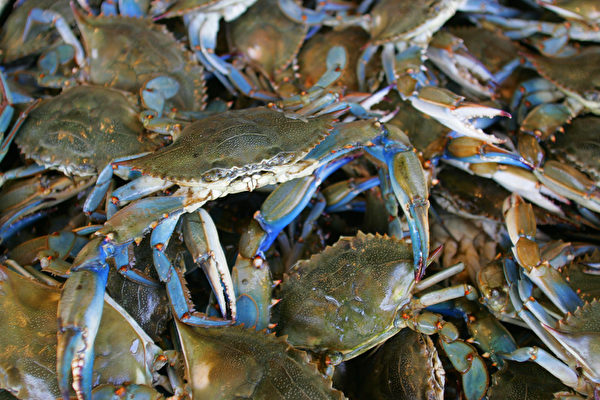Just as tourists crowd the holiday resorts in Italy, blue crabs have also become an invasive species, causing massive damage to marine ecosystems. Blue crab, a delicacy on the dining tables of Chinese, Korean, and even American people, has become a headache for the Italian government. The presence of blue crabs may even alter Italy’s culinary culture, posing a challenge for local chefs.
Blue crabs, also known as blue swimmer crabs or Callinectes sapidus, are originally from coastal waters of North and Central America, with those from the Chesapeake Bay in Maryland being the most famous. Since the mid-18th century, blue crabs have been an essential part of the state’s economy and a delicious dish on American tables.
Having arrived in the Mediterranean on cargo ships 15 years ago, blue crabs have seen a sudden exponential increase in their population due to warmer climates and lack of natural predators. They are voraciously feeding on clams and mussels, causing severe losses to the fishing industry in Veneto, Italy.
In August, fishermen reported catching more blue crabs than clams. These crabs prey on juvenile clams, mussels, and oysters, destroying up to 90% of the juvenile clam population in the region, causing severe harm to future production. This invasion prompted the Italian government to allocate 2.9 million euros (approximately 3.2 million dollars) to protect the local fishing industry from crab infestation.
Italian chefs are facing the invasion of blue crabs as a formidable challenge. On one hand, they must protect their traditional culinary culture from being disrupted, while on the other hand, they must use their creativity to cook blue crab dishes that the local residents can accept, thus alleviating the pressure caused by the invasion.
Reported by The Washington Post, many Italian chefs are concerned that blue crabs may completely replace the marine ecosystem in the Adriatic Sea.
Chef Denis Begiqi of Ristorante Adriatica in Venetian Il Palazzo Experimental hotel stated, “In my view, we must make every effort to protect this heritage that we own.”
Begiqi and other chefs in the region are adapting to blue crabs, not only viewing them as pests but also as potential ingredients. They are incorporating blue crabs into their menus with extraordinary creativity. In one event, Begiqi and his sous chef Francesco Donaggio used blue crabs as stuffing for ravioli, as well as ingredients for pasta dishes and risottos, and made dumplings and crab meatballs known as cicchetti.
Italians are not unfamiliar with eating crabs, including granseola (spider crab) which can be used to make delicious pasta, and moeche, a small soft-shell crab caught during spring and October shedding, which can be deep-fried and is a classic dish in Venice. However, blue crabs are considered as “alien food” to them.
Amidst the invasion of blue crabs, some Venetians remain loyal to moeche, believing its taste aligns more with the Mediterranean palate. However, there are others who are beginning to appreciate the versatility and affordability of blue crabs. Environmentally conscious chefs are finding ways to use blue crabs as an ingredient.
At Antinoo’s Lounge & Restaurant in Sina Centurion Palace, Executive Chef Giancarlo Bellino has been featuring blue crab as a specialty dish since last year, including delicious fried crab cakes and crab meat. Bellino is experimenting with more creative recipes involving blue crabs, including blue crab dumplings.
The affordability of blue crabs is a significant advantage. This summer, the price of large hard-shell blue crabs is around $2.50 per pound, with most crabs being larger in size.
The Washington Post reports that Ryan Speckman, co-founder of Locals Seafood in North Carolina, mentioned that their retail customers can expect to pay up to $6.50 per pound for larger male blue crabs, while smaller, lower-quality crabs are priced as low as $2.50 per pound. During the “soft-shell crab season,” prices can reach as high as $9 per pound.
There is no sign of the blue crab invasion weakening. “Historically, Italian recipes take several years to form,” says Begiqi. “This is where we, as young chefs, come into play. We must strive to create good recipes that everyone can use.”

